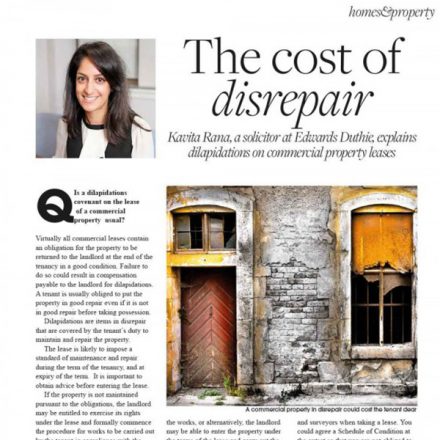The cost of disrepair
Is a dilapidations covenant on the lease of a commercial property usual?
Virtually all commercial leases contain an obligation for the property to be returned to the landlord at the end of the tenancy in a good condition. Failure to do so could result in compensation payable to the landlord for dilapidations. A tenant is usually obliged to put the property in good repair even if it is not in good repair before taking possession. Dilapidations are items in disrepair that are covered by the tenant’s duty to maintain and repair the property.
The lease is likely to impose a standard of maintenance and repair during the term of the tenancy, and at expiry of the term. It is important to obtain advice before entering the lease.
If the property is not maintained pursuant to the obligations, the landlord may be entitled to exercise its rights under the lease and formally commence the procedure for works to be carried out by the tenant in compliance with the leasehold obligations.
At the end of the lease, the tenant is required to hand the property back to the landlord in the condition set out under the terms of the lease. If the tenant does not do so, the landlord may be entitled to serve a notice to reinstate on the tenant.
When serving the notice to reinstate, the landlord should also send to the tenant a Schedule of Dilapidations, prepared by a specialist surveyor, identifying the breaches, remedial work required, and providing costings. If the tenant fails to remedy the breaches identified, the landlord may take enforcement action. This could include commencing a claim for a Court Order requiring the tenant to carry out the works, or alternatively, the landlord may be able to enter the property under the terms of the lease and carry out the works itself, thereafter claiming back from the tenant damages for the value of the repair works. Alternatively, the landlord may opt to pursue a forfeiture of the lease as an alternative remedy.
The amount claimed by the landlord must only relate to the actual cost. There is no statutory cap on the damages value of the claim although the repair costs claimed should not exceed the amount by which the value of the landlord’s interest in the premises is diminished.
Dilapidations is a complex area of law and can result in a claim of hundreds of thousands of pounds. It is therefore essential to remember three important things when entering into a commercial lease: 1. Seek advice from both lawyers and surveyors when taking a lease. You could agree a Schedule of Condition at the outset so that you are not obliged to put the property in any better condition than is in when you take the lease; 2. Be aware of and comply with your duties and liabilities under the lease; and 3. Obtain proper advice from lawyers and surveyors in respect of pursuing, or receiving, any claim for dilapidations.
Article from www.westessexlife.co.uk
